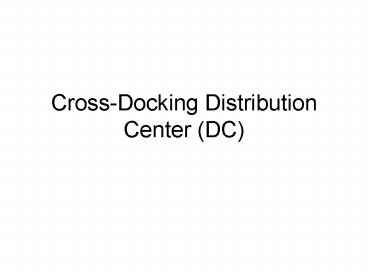Cross-Docking Distribution Center (DC) - PowerPoint PPT Presentation
1 / 20
Title:
Cross-Docking Distribution Center (DC)
Description:
The Cross-docking requirements The systems for a successful cross-docking on a large scale include: automated material handling, warehouse management systems ... – PowerPoint PPT presentation
Number of Views:1518
Avg rating:3.0/5.0
Title: Cross-Docking Distribution Center (DC)
1
Cross-Docking Distribution Center (DC)
2
Three ways for the distribution
- 1. Traditional Warehousing/Distribution, in which
vendors ship goods to retail DCs, where the goods
are stored until store orders need fulfilled,
where they are then picked (often using a "wave"
process" for batches of stores) and delivered to
the stores. - 2. Crossdock DCs, in which shipments from inbound
suppliers are moved directly to outbound
vehicles, with very little if any storage in
between. In the best possible situation, products
never touch the floor or a shelf, though some
amount of staging is often used. - 3. Direct to Store Delivery, in which vendors
ship goods directly from their own facilities to
retail store outlets.
3
The trade offs of crossdocking
Traditional
Crossdock
Direct to Store Delivery
4
Cross-Docking
- Cross-docking favors the timely distribution of
freight and a better synchronization with the
demand. - It is particularly linked with the retail sector
(often within large retailers), but can also be
apply to manufacturing and distribution. - Cross-docking is mainly dependant on trucking.
5
Advantages of Cross-Docking
- Minimization of warehousing and economies of
scale in outbound flows (from the DC to the
customers). - The costly inventory function of a DC becomes
minimal, while still maintaining the value-added
functions of consolidation and shipping. - Inbound flows (from suppliers) are thus directly
transferred to outbound flows (to customers) with
little, if any, warehousing. - Shipments typically spend less than 24 hours in
the distribution center, sometimes lt 1 hour.
6
Direct to Store Delivery
LTL Less than Truckload
7
Cross-Docking
TL Full Truckload
8
Cross-Docking DC
Suppliers
Receiving
Sorting
Shipping
Customers
9
Pre- and post-distribution
- In pre-distribution cross-docking, the customer
is assigned before the shipment leaves the
vendor, so it arrives to the cross-dock bagged
and tagged for transfer. - In post-distribution cross-docking, the
cross-dock itself allocates material to its
stores. - For example, a cross-dock at a Wal-Mart might
receive 20 pallets of Tide detergent without
labels for individual stores. Workers at the
cross-dock allocate 3 pallets to Store 23, 5
pallets to Store 14, and so on.
10
Comments
- Pre-distribution is definitely more difficult to
implement because the vendors of the cross-dock
must know which customers of the cross-dock need
what before they send the shipment. - This involves quite a bit of information
transfer, system integration, and coordination.
11
The Cross-docking requirements
- The systems for a successful cross-docking on a
large scale include - automated material handling,
- warehouse management systems (WMS),
- order processing systems,
- quality controls systems,
- strong relationships between supply chain
partners.
12
Automated material handling systems
- An automated cross-docking system typically
consists of a series of conveyors for receiving
and sorting cases. - Barcode scanners read an identification code on
each case to track the product through the
cross-dock system and, based on information from
a WMS or an order system, the automated system
sorts the cases to trucks or pallets for
shipping. - Bartolini Roma Sorting.wmv
13
Warehouse management system
- Controlling the flow is critical in
cross-docking. - A WMS accomplishes this by receiving product
information via WEB or EDI and keeping track of
product movement. - It supports the real-time requirements of
cross-docking, receiving order details from
customers and later informing them of the
shipment's carrier and arrival date and time. - The WMS also tracks warehouse performance,
including labor and dock utilization.
14
Importance of tracking performance
- Cross-docking demands a reallocation of
resources, shifting the emphasis away from
storage and order picking to receiving and
shipping. - For example, peak workload may intensify because
it's more difficult to evenly distribute workload
in cross-docking. - Thus, the peak workloads length and when it
occurs must be studied to utilize labor and dock
equipment most effectively.
15
The software
- Business systems may require special
functionality to efficiently allocate inbound
goods to existing orders, matching supply to
demand. - Some WMS permit opportunistic cross-docking
functionality to allocate received product to
current demand in real-time. - And there is little stress on software systems
when buyers predetermine distribution for special
purchases or seasonal items.
16
Quality control (QC)
- Stringent yet agile operations are increasingly
important as the volume of cross-dock business
increases, especially when handling new
suppliers. - Good QC is essential to avoid delays,
bottlenecks, or the costs associated with
shipping inferior product.
17
Partner relationships
- Failing to establish a good working relationship
with your supply chain partners can lead to
failure in a cross-dock endeavor. - The sharing of information, clear communication,
confidence in the quality and conformance of
goods, and product availability are a few
characteristics that produce effective
cross-docking.
18
The plan
- Although the concept of cross-docking is simple,
its implementation is complicated. - Careful preparation is a must.
- Logistics managers who want to switch to this
rapid system have to first establish a formal
plan, including starting a cross-docking pilot
program and evaluating its effectiveness.
19
The implementation
- Once the plan is set, logistics managers must
partner with other members of the supply chain to
implement the system. - Since cross-docking affects the entire supply
chain, everyone's cooperation must be gained and
adjustments made wherever necessary.
20
The cost structure adjustments
- For example, if manufacturing has to pay extra
costs to enable cross-docking through the supply
chain, then the manufacturing cost structure must
be readjusted appropriately. - This applies to every member of the supply chain,
such as trucking and packaging.

